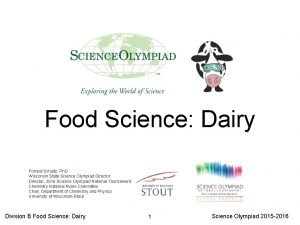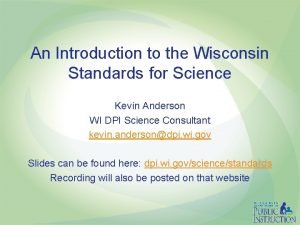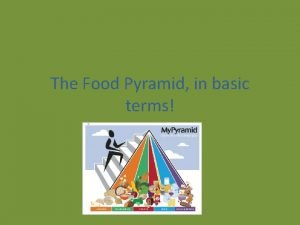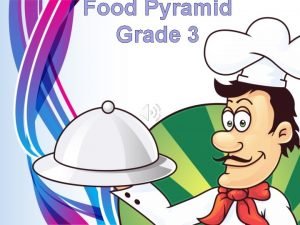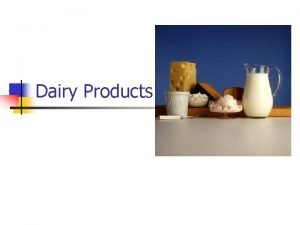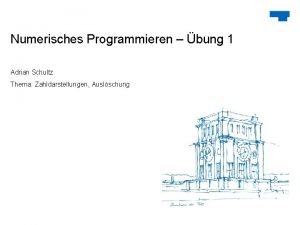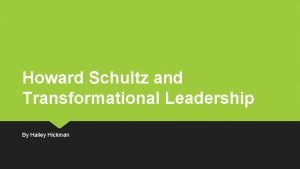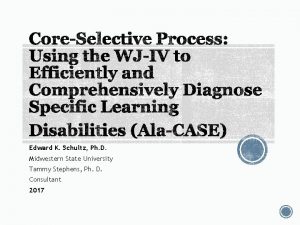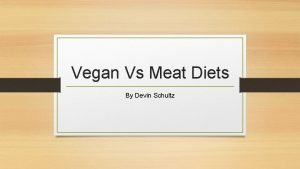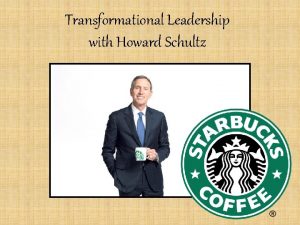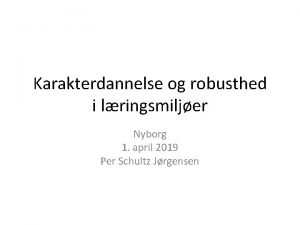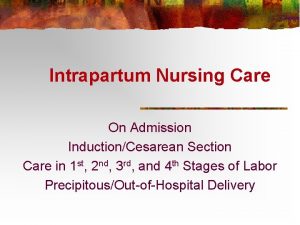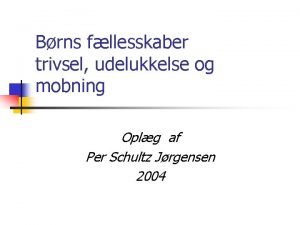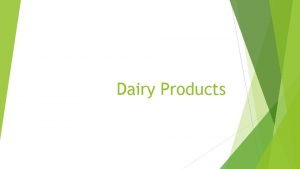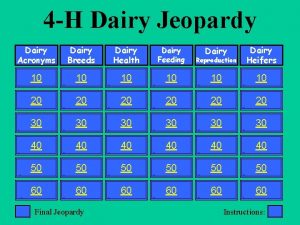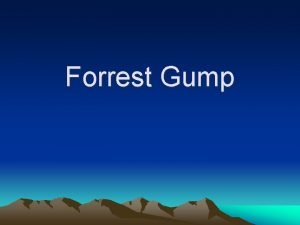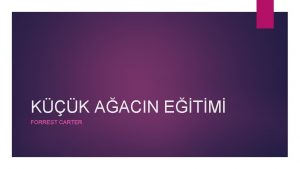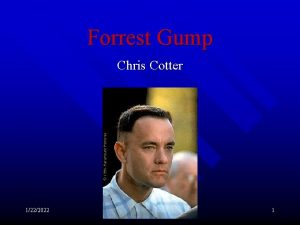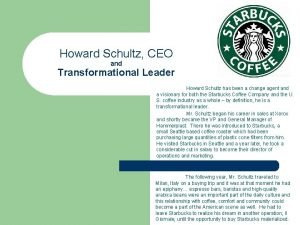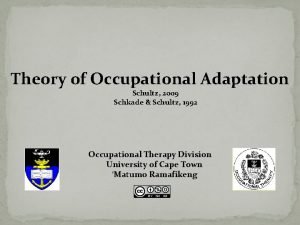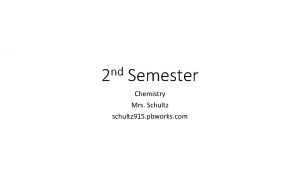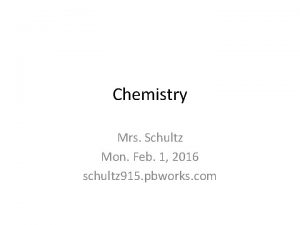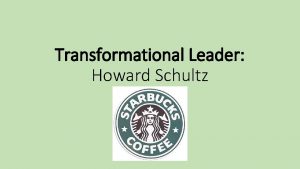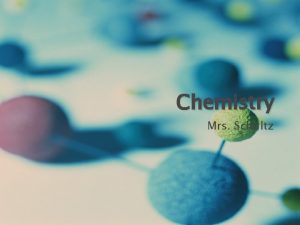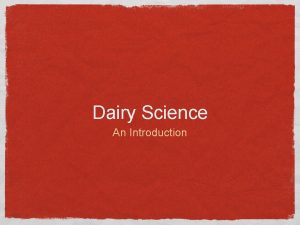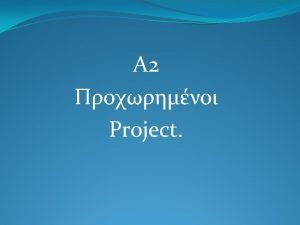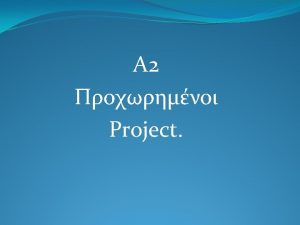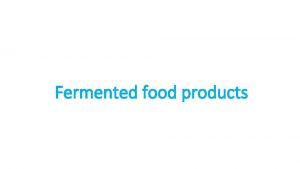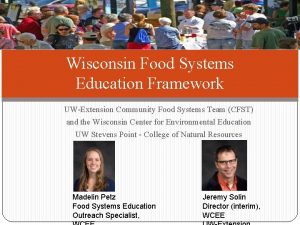Food Science Dairy Forrest Schultz Ph D Wisconsin





















- Slides: 21

Food Science: Dairy Forrest Schultz, Ph. D Wisconsin State Science Olympiad Director, 2016 Science Olympiad National Tournament Chemistry National Rules Committee Chair, Department of Chemistry and Physics University of Wisconsin-Stout Division B Food Science: Dairy 1 Science Olympiad 2015 -2016

Please Note • This recommended guidance suggests only one of a variety of ways for teams to record their mass that an Event Supervisor may use. Teams may be asked to submit a sample for massing using a variety of procedures that teams need to verify with their Regional or State Director/Event Supervisor. Division B Food Science: Dairy 2 Science Olympiad 2015 -2016

Event Process • Learn about making ice cream, curds and butter • Practice and experiment making these products while developing a notebook • Attend tournament and take written test and make products, impound notebook and bring supplies • HAVE FUN!!!! Division B Food Science: Dairy 3 Science Olympiad 2015 -2016

Event Parameters Comments/Suggestions Teams are to bring all of the equipment needed, Event Supervisors will provide things like balances. Students: Each team must bring safety equipment, a writing implement, a calculator and the materials listed below needed to prepare ice cream and perform the curd mass analysis and/or the milk fat mass analysis. Lots of paper towels may be needed. Each team may bring 5 pages (both sides) containing information in any form from any source (sheet protectors are permitted). Teams must bring Gloves (winter type or lab hot/cold) are REQUIRED for only plastic bags, cups, spoons, graduated cylinders, 500 -600 m. L plastic ice cream production container with lids, cheesecloth, beakers, p. H paper, paper towels, gloves, and a towel. Glove types must be of competitor’s choice. Supervisors: will provide necessary milk products (any type of milk may be provided including powdered), salts, lemon juice, vinegar, ice (if necessary), thermometers, or other reagents or equipment to complete the experimental activities. The provided quantity of milk product will be between 125 and 150 ml depending on which Lab is being used. The amounts provided shall be the same for each student. Event Supervisors are to provide all necessary milk products. For the making of ice cream, anticipate 1 -2 lbs. of ice for each team Safety Requirements: Students must wear goggles, an apron or a lab coat, gloves (for ice cream Lab only), and have skin covered from the neck down to the wrist and toes. Long hair, shoulder length or longer, must be tied back. Students who unsafely remove their safety clothing/goggles or are observed handling any of the material or equipment in an unsafe manner will be disqualified from the event. Eye Protection CATEGORY C • Description: Indirect vent chemical/splash protection goggles. These seal tightly to the face completely around the eyes and have indirect vents constructed so that liquids do not have a direct path into the eye (or no vents at all). If you are able to see through the vent holes from one side to the other, they are NOT indirect vents • Corresponding ANSI designation/required marking: Z 87 (followed by D 3 is the most modern designation but, it is not a requirement) • Example: Indirect vent chemical/splash protection goggles Notes: 1. A goggle that bears the Z 87+ mark and is an indirect vent chemical/splash protection goggle will qualify for all three Categories A, B & C 2. Visor. Gogs do not seal completely to the face, but are acceptable as indirect vent chemical/splash protection goggles Division B Food Science: Dairy 4 Science Olympiad 2015 -2016

What is Milk? A mixture of Fat, Protein, Carbohydrate, Minerals, and Vitamins. The fat and protein exists as a colloidal suspension in a matrix of water which contains water soluble carbohydrate and minerals. Milk under a microscope and magnification of 800 x http: //dairydream. blogspot. com/2012/08/pasteurized-vs-raw-milk-under-microscope. html Division B Food Science: Dairy https: //www. uoguelph. ca/foodscience/book-page/milk-structure 5 Science Olympiad 2015 -2016

SEM* image of dried Milk This is a fantastic image that shows the large colloidal structure of the milk fat globules and the smaller colloidal structure of the milk proteins casein. Minerals and vitamins are much smaller and cannot be seen in this image. Calcium minerals are associated with the proteins, while vitamins A and D are fat soluble vitamins and are within the fat globules. Even bacteria can be seen! Streptococcus Casein Fat Globule *SEM-scanning electron microscopy Division B Food Science: Dairy 6 Science Olympiad 2015 -2016

Recommended Websites on Milk National SO Event Site SO specific Information and notebook standard experimental form are found here. https: //www. soinc. org/food_science_b Excellent Scientific and Experimental Overview https: //www. uoguelph. ca/foodscience/book-page/dairy-science-and-technology-ebook https: //www. ilri. org/Info. Serv/Webpub/fulldocs/ilca_manual 4/Milkchemistry. htm Applications and General Knowledge The Overview and General Knowledge links are excellent study resources for the experimental tasks and written test components of the event. http: //www. eatwisconsincheese. com http: //www. healthyeating. org/Milk-Dairy/Scientific-Research. aspx http: //www. ift. org/knowledge-center/learn-about-food-science. aspx Division B Food Science: Dairy 7 Science Olympiad 2015 -2016

Common Milk Products Definitions of milk products: http: //www. idfa. org/docs/default-source/resource-library/industry-facts/248_definitions-of-milk-products. pdf? sfvrsn=2 Whole Milk: 4% 2% Milk: 2% Skim Milk: <0. 5% Half-and-Half: 12% fat Light Cream: 20% fat Light Whipping Cream: 30% fat Whipping Cream: 35% fat Heavy Cream and Heavy Whipping Cream: 38% fat Fresh Cheeses: http: //www. foodsubs. com/Chefresh. html Division B Food Science: Dairy 8 Science Olympiad 2015 -2016

Science of Milk Particles The main proteins and fats in milk consist of rather large particles referred to as colloidal particles. These particles have a negative charge associated with them at the p. H of milk which is typically just above 7. This charge characteristic of these particles keeps the particles separated and suspended in the water of milk. If it were not for this charge, the particles would quickly settle out of the water. For example, fat particles would rise to the top, since their density is less than water and the molecules are not miscible(soluble) in water. There are some proteins that are water soluble and do not exist as these colloidal particles, they are referred to as whey proteins. Water surrounds the particles and contains soluble carbohydrates like lactose. Protein Negative charges surround the colloidal particles Fat Protein Fat Division B Food Science: Dairy 9 Science Olympiad 2015 -2016

Science of Curd Formation When acid or H+ ions are added to milk they react with the negatively charged molecules on the surface of the colloidal particles. This acid-base reaction neutralizes the charge. When the particles no longer carry a charge, they no longer repel one another and collapse into a precipitate. This precipitate is what we call a curd. The acid can come from common acidic liquids like vinegar or lemon juice. When bacteria grow they consume the lactose in milk and produce lactic acid which also leads to the curdling of milk. The neutralization p. H is typically around 5. Fat acid provides H+ Protein Fat after acid addition Fat Curd Fat 10 Division B Food Science: Dairy Protein Science Olympiad 2015 -2016

Curds and Whey The whey contains water soluble components of milk, while the large protein and fat particles are obtained through separation techniques to isolate the curd. Even though the calcium compounds in the milk could be water soluble, then tend to be bound to the proteins, so the curd also contains calcium minerals. Since lactose tends to be more water soluble, curds tend to not contain a lot of lactose. Division B Food Science: Dairy 11 Science Olympiad 2015 -2016

Curd Formation Techniques, Ideas and Comments Filtration-paper towels work well, cheese cloth certainly can be used and a variety of fabrics also work very well and are stronger than paper towels. Funnels are recommended. Pressing or Squeezing is a Collecting the curd common process in the precipitate can be tedious, formation of cheese products. but a common laboratory Pressing the curds in a cloth technique in which to greatly accelerates the become skillful removal of the whey. Drying the curd formation by continued pressing in dry paper towel is very effective. This can lead to a constant mass which could be used for scoring by an Event Supervisor A Cheese Ball can be formed by the pressing technique and lead to a ball that can be handed to an Event Supervisor on a toothpick for massing, too wet and it will fall off! Typical milk products contain a large quantity of curd, which means that a significant amount of acid may need to be added. Prior experimentation couple with checking of the p. H can help identify the proper quantity of acid to add. Unlike some chemical reactions with small molecules, the protein and lipid colloidal particles require some time to coagulate. The coagulation time may be a good independent variable to explore in prior experimenting. Also, during coagulation, constant stirring may not be desired as particles come together. More coagulation of the curd may lead to an easier and more complete separation process. Division B Food Science: Dairy 12 Science Olympiad 2015 -2016

Science Butter Formation The fat globules have a center component consisting of a mixture of a variety of lipids. The outer layer (shown in red) is a layer referred to as phospholipid layer. This layer surrounds the inner lipid (fat) particle and carries the negative charge. In the making of butter, the p. H is not altered. The fat globules are forced together (called churning) into larger particles of fat. As these particles continued to “smash” into one another, the phospholipid layer breaks open and the fat molecules come together in larger particles. After continued churning, the particles become so large that they come together has a large mass of what we call butter. The remaining liquid is called butter milk. Butter begins with cream which as a high milk fat content. The high content is needed so that the particles can actually collide with one another in a reasonable amount of time. Fat Collide these violently! Fat Division B Food Science: Dairy Fat 13 Science Olympiad 2015 -2016

Butter Formation Techniques, Ideas and Comments A plastic wide-mouth container with a tightfitting top is needed. The container needs to be shaken violently to force the fat globules together. Glass jars are not allowed since breakage can occur. As the cream is shaken, a stage called “whipped cream” occurs. This is not yet butter. Violent shaking is required to get through this stage. Division B Food Science: Dairy The butter “ball” can then Once the buttermilk is be dried in paper towel released from the cream, and then massed for a ball of butter will exist in scoring. The butter will the cup. The liquid tend to stick together buttermilk is decanted better than the curds. But from the butter mass. moisture may still be The butter can be rinsed prevalent. with cold water. 14 With a little pressing in paper-towel the butter can also be placed on a toothpick to be massed by an Event Supervisor. Science Olympiad 2015 -2016

Science of Ice Cream Ice cream is a mixture of milk, air and sugar. Ice cream is not only really yummy, but it is a rather amazing material. Ice cream has unique material properties like being “scoopable" while retaining its shape Unlike butter and curds, ice cream contains much water. This water is important as it interacts (through hydrogen bonding) with sugar. The water and sugar matrix along with ice crystals gives ice cream much of its properties. The other key ingredient is air which leads to greater volume and desirable characteristics we enjoy as we eat ice cream. In making ice cream, constant agitation of the ingredients is needed while the temperature is lowered. Once the temperature is low enough, the ingredients are “locked” into a matrix as shown in the drawing (B) and microscopic image (A). http: //g 4 icecreamproject. blogspot. com/2013/06/practical-4 -investigating-fat-and-air. html Division B Food Science: Dairy 15 Science Olympiad 2015 -2016

Making Ice Cream A common and simple method to make ice cream is to mix milk/cream and sugar in a plastic bag which is then placed in another bag with a salt/ice mixture. This method works well, but other methods certainly could be utilized, such as plastic storage containers. The plastics bags can puncture if one is not careful, especially with rock salt. The bags will get very cold!!! Frostbite is a concern. Teams are required to wear some sort of thermal protection gloves. Division B Food Science: Dairy 16 Science Olympiad 2015 -2016

Written Test TEST TOPICS: Teams will take a written exam that covers only dairy food science topics such as: the role of lipids, carbohydrates and proteins typically found in dairy foods; standard labeling regulations; basic organic reactions such as esterification, fat bonding; saturated and unsaturated fats; chemical structure of sugars, starches, fats, and proteins; essential fats, vitamins, proteins; how cooking changes dairy foods chemically; allergens in dairy foods; dairy food preservation; RDA (recommended daily allowance) of essential minerals and vitamins in dairy foods and the consequences of not having them; freezing point depression; nondairy ‘milk’ products; lactose free milk; health benefits of dairy foods; low fat, fat free milk; lactose intolerance; emulsification; pasteurization; organic dairy products; casein and whey proteins; probiotics. Teams will be provided a written test based on the topics listed in the rules. The Recommended Websites indicated earlier in this document are excellent resources for the written test. Since Food Chemistry is in the Physical Science category, a focus should be placed on the chemistry of diary products and the molecules contained within them. SAMPLE TEST QUESTIONS: i. What is the protein that is most common to cow’s milk? ii. Does table salt or rock salt produce a greater freezing point depression? iii. What are the chemical compositions and nutritional values of 2% milk, skim milk, half, cream and whole milk? iv. What are the chemical structures and names of the common fats in dairy products? v. How does soy milk compare and contrast with cow’s milk? Division B Food Science: Dairy 17 Science Olympiad 2015 -2016

Notebook NOTEBOOK: Prior to the tournament, teams must perform 3 or more experiments for each of the three Lab Tasks below. These experiments must be recorded on the Food Science Experiment Form (see on www. soinc. org) and must be placed together in the Notebook. Students are encouraged to do more than nine experiments, but only the first 3 for each task will be graded. Each experiment will constitute one entry in the Notebook and each must have only one Independent Variable. The Notebook will be impounded prior to the start of the tournament for grading. At the Science Olympiad website (soinc. org) under the B/C Events menu is a link to Resources and Links for Food Science. At this page is a link to a Food Science Experiment Form. This form (see at left) is to be utilized to record the results of experiments performed by teams before the tournament. The experiments in the notebook should be experiments, and not just a record of making a dairy product. Many of the aspects of the Experimental Design scoring rubric should be considered. Things like trials and collecting data for at least three changes of an independent variable should be considered. Depending on the impound procedure at a tournament, it may be possible that teams do not have access to these notebooks during their event. This is where prior experimental information may need to be included in the 5 pages of notes that each team can bring to the competition. Division B Food Science: Dairy 18 Science Olympiad 2015 -2016

Scoring SCORING: High score wins. Final Score = Notebook Score + Lab Task(s) Score + Test Score - Penalties. a. Notebook Score = Complete experiments receive up to 2 points each. Incomplete experiments receive fewer points (maximum 18 points). b. Lab Tasks Score = Total of score(s) of required Lab(s) i. Ice Cream Score = 0. 1 pts for each mm (rounded off) of height (e. g. , Team gets 125 mm x 0. 1=12. 5) ii. Curd Mass and the Milk Fat Mass Scores = Team mass/Supervisor mass x 10 (e. g. , Team get 2. 4 g Supervisor gets 2. 5 g = 0. 96 x 10 = 9. 6) (maximum 10 points each). c. Test Score = Percentage correct/2 (maximum 50 points) d. Penalties: Up to 10% of total possible score may be subtracted for failure to clean up as instructed. e. Tie Breaker: Preselected questions on Test f. Scoring Example: Notebook Score was 18, Ice Cream Score 12. 5, Curd Mass Score was 9. 6, Test Score was 90%, No Penalties. Final Score = 18 + 12. 5 + 9. 6 + 90/2 = 85. 1 Scoring is a combination off team performance on the Notebook, Written Test and Lab Tasks. The Event Rules indicate which Lab Tasks could be performed at the tournaments. See below: LAB TASKS: At the tournament, teams will use the provided food materials to perform the tasks. At Regionals teams will only perform one of the tasks. At State Tournaments students will be asked to complete one or two of the tasks. At Nationals, students will be asked to perform two or three. As teams practice their events, it is anticipated that they will become more efficient in their experimental processes. Division B Food Science: Dairy 19 Science Olympiad 2015 -2016

Scoring - Ice Cream The scoring of the ice cream lab task is based on the height of the ice cream “tower” that can be formed by the teams. Event Supervisors will make these measurement according to a process explained to the teams. Although ice cream can melt, it is really an amazing material in that it holds its shape extremely well at a variety of temperatures. Height Measurement Division B Food Science: Dairy 20 Science Olympiad 2015 -2016

Scoring - Curds and Butter and Curd on a Stick! The scoring for these Lab Tasks is based on a team’s ability to properly isolate the curd or butter from milk products. Event Supervisors may provide guidance to a variety of ways for teams to record their mass or teams may be asked to submit a sample for massing by the Event Supervisor. One of the real aspects of cheese curds and butter is moisture content. Moisture is an important aspect which leads to certain characteristics for these materials that we seek in these materials as consumers. However, this can lead to challenges in making mass measurements of the resulting products. Event Supervisors will most likely provide guidance at tournaments on how they plan to gather or make the mass measurements. Experimental knowledge and experience will be needed by teams to work with the curds and butter. Techniques such as filtration, decanting and drying of the products will be important. Division B Food Science: Dairy 21 Science Olympiad 2015 -2016
 Forrest schultz
Forrest schultz Wisconsin science standards
Wisconsin science standards Dairy food pyramid
Dairy food pyramid Food pyramid learning objectives
Food pyramid learning objectives Dairy products includes
Dairy products includes Subject science
Subject science Unit 2 food food food
Unit 2 food food food Food chain food chain food chain
Food chain food chain food chain Binäre gleitkommazahl
Binäre gleitkommazahl Defination of hypersensitivity
Defination of hypersensitivity Howard schultz management style
Howard schultz management style Howard schultz leadership qualities
Howard schultz leadership qualities Howard schultz transformational leadership
Howard schultz transformational leadership Dr edward kelly
Dr edward kelly Puntos toconomicos
Puntos toconomicos Jonathan schultz jenny jones
Jonathan schultz jenny jones Devin schultz
Devin schultz Howard schultz transformational leadership
Howard schultz transformational leadership Per schultz jørgensen risikomodel
Per schultz jørgensen risikomodel Dirty duncan and shiny schultz
Dirty duncan and shiny schultz Placenta tipo duncan y schultz
Placenta tipo duncan y schultz Per schultz jørgensen model
Per schultz jørgensen model
